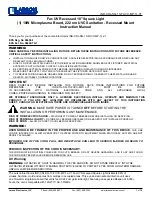
period to mice. In both tests (skin samples and chronic exposure), traditional UV sanitation
lights in the 254 nm range were tested using the same types of samples for comparison.
After exposure to 222 nm light, the skin samples in the first test did not produce lesions or
display signs of irritation, as well as did not generate damaging levels of cyclobutane pyrimidine
dimers (CPD) and pyrimidine-pyrimidone 6-4 photoproducts (6-4PP). In the second set of tests
involving mice, researchers analyzed the effects of the UV-C lights on the epidermis (skin).
Observations were taken 48 hours after exposure. The results showed that the skin of mice
exposed to far-UV 222 nm lights did not significantly increase in epidermal thickness at 20.1
um. While mice exposed to traditional 254 nm UV-C lamps displayed 60.9um or a 3-fold
increase in epidermal thickness. This reaction is closely associated with severe tissue
hyperplasia, i.e. an increase in cellular proliferation that can lead to (but not always) tumors
and cancer. Based on the results from the tests, the researchers concluded that far-UV 222 nm
light can be recommended as an effective sanitation method. According to the researchers, this
form of UV germicidal treatment can be administered safely without extensive protective
clothing and imposing significant risks related to skin cancer.
In a 2019 study
7
, scientists compared the effects of far-UV 222 nm and 254 nm light on the
cornea. The cornea is the outer layer of the eye that acts as a protective barrier against
irritants, such as debris and bacteria, and plays a primary role in light absorption. Damage to
the cornea often results in vision impairment or loss. During the study, researchers exposed
rats to 222 nm and 254 nm lights at 30, 150, and 600 mJ/cm
2
intensities. The animals exposed
to far-UV 222 nm did not display corneal damage. Moreover, cyclobutane pyrimidine dimer-
positive cells were not present in the samples exposed to 222 nm, which reduces cellular
proliferation risks responsible for cancer. By comparison, UV 254 nm imposed a wide range of
damage at various UV intensities on the samples. At 600 mJ/cm
2
, corneal erosion was evident.
Superficial punctate keratis (eye disorder from cellular death on the cornea) was observed on
samples exposed to UV 254 nm at doses higher than 150 mJ/cm
2
.
4.3 Germicidal Effectiveness
In the 2017 study from section 4.2, scientists tested the effectiveness of 222 nm on MRSA
(USA300, multilocus sequence type 8, clonal complex 8, staphylococcal cassette chromosome
mec type IV). The samples were separated and exposed to 222 nm excimer lamps (filtered) and
254 nm lights for comparison. The results of the tests showed 222 nm bands to be “almost as
efficie
nt” in eliminating MRSA as conventional 254 nm.
At 222 nm, UV light is capable of inactivating airborne aerosolized viruses at low doses. A 2018
study
8
presents the effectiveness of this type of artificial light source in eradicating aerosolized
H1N1 influenza virus. In the study, researchers used excimer lamps as a primary disinfection
device. A far-UV dose of
2 mJ/cm
2
was administered on the sample. The lights were positioned
11 cm from a UV transparent plastic film, with a 65 percent transmission rate. A certified class II

































